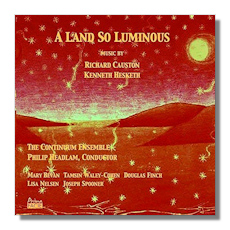
The Internet's Premier Classical Music Source
Related Links
- Latest Reviews
- More Reviews
-
By Composer
-
Collections
DVD & Blu-ray
Books
Concert Reviews
Articles/Interviews
Software
Audio
Search Amazon
Recommended Links
Site News
 CD Review
CD Review
A Land So Luminous

- Kenneth Hesketh
- A Land So Luminous for Violin & Piano
- Cautionary Tales for Clarinet, Violin & Piano
- IMMH for Cello
- Netsuke for Ensemble
- Richard Causten
- Threnody for Soprano, 2 Clarinets & Piano
- Rituals of Hunting & Blooding for Ensemble
- Non Mi Comporto Male for Piano
- Sleep for Flute
- Night Piece for Piano
The Continuum Ensemble/Richard Headlam
Prima Facie PFCD051 78:56
The Continuum Ensemble, a leading U.K. contemporary music group, is dedicated to "developing an enduring body of work by composers of our time." Their programmes have included works by Harrison Birtwistle, Oliver Knussen, John Tavener, John Harbison, György Ligeti, Tristan Murail, Frederic Rzewski, Lou Harrison, Colin McPhee, Iannis Xenakis, Henri Dutilleux, Hans Werner Henze, as well as German and Austrian exiles from the Nazi period including Ernst Toch, Kurt Weill, Ernst Krenek, Erwin Schulhoff and Stefan Wolpe, just to mention names best known to me.
Kenneth Hesketh (b. 1968) and Richard Causten (b. 1971) are presented by the Continuum Ensemble's as outstanding among the most recent British composers. I take it that these dozen short pieces are representative of their styles.
The album title work by Hasketh, in a single movement running nearly eleven minutes, was originally (2003) for violin and instrumental ensemble; it was inspired by a 17th-century science fiction-like episode written by Cyrano de Bergerac. Here, the violin is first partner, then antagonist, to the piano. The opening, far from luminous to my ears, features harsh attacks by the violin and rapid staccato from the piano. However, the mood becomes quiet, gentle and slow after four minutes of this. Following renewed stridency, the work ends with a very high note on the violin and a very low tone on the piano.
Cautionary Tales are short aural representations of things to avoid lest painful consequences ensue. The first and third are based on 19th century moralizing instructions for children; the second is based on Le Petit Prince. Meant to be whimsical, at least one of these tales seems downright cruel. They are all extracted from the ensemble piece, Netsuke.
IMMH is an "imagined shamanic ritual marking the passage from life to death." A single note given contrasting rhythms is succeeded by melodic fragments which "proliferate ever more elaborately." Rhythms are tapped on the body of the cello and the player sings ecstatically and percussively creating a slow dance-like cortège, ending with ethereal harmonics. It is dedicated to the memory of Michael Harrison.
Netsuke was commissioned by Hans Werner Henze for the occasion of his 75th birthday. The opening section takes up the thumb-sucker from the previous set and has a very loud and harsh opening; it is not pleasant at all. La Rose, which follows, is much nicer, especially the clarinet part. The ending of this is abrupt. The final section, "The Owl," its title from a poem by Walter de la Mare, shows its feathery subject sleepy by day and a fierce hunter by night. Musically, a bassoon is in contrast with a trilling flute and some tinkling percussion.
Causton's Threnody (1991) is a setting of a poem by Marina Tsvetayeva (1892-1941). Its text, in eight lines, is provided in the notes, and is about giving up struggle in the evening of life, with sleep under the earth to follow. Threnody opens and closes with slow and mournful sounds from the clarinets, which, along with a piano, provide background harmony to the soprano's melodic line. A powerful climax precedes a final sense of resignation.
Rituals of Hunting and Blooding (2000-2002) begins with the prey, represented by a clarinet, chased by hunters – the other instruments. Dances crowd one another with increasing momentum and energy, representing the diminishing space between hunters and hunted. A trumpet plays solo against a trio of trombone, bass and percussion. A piccolo alone is calm against "spiky, visceral" brass rhythms ending in a "wild, violent climax." The succeeding movement features winds playing a "richly sonorous chorale answered by the violin with a solemn, wide-ranging melody in double-stops" along with a double bass. The rituals end with deep bell-ringing.
Non Mi Comporto Male moves through sections marked Fantasia, Flamboyant, Inqueto, Meccanico, Maestoso and Adagio before slowly revealing a melody hidden till the end. Textures are dense and the keyboard registers show extreme separation.
Sleep, inspired by a poem by George Seferis, was commissioned by Henry Greenfield in memory of his wife, Joanna. The piece is short but I have no hesitation in calling it beautiful.
Night Piece is a reworking of the Adagio of Mozart' Clarinet Concerto. The atmosphere is dream-like. The ending, with Mozart's original harmony, is particularly beautiful.
I cannot say that I enjoyed all three pieces equally, but this release is recommended to those interested in recent musical developments in Britain.
Copyright © 2017, R. James Tobin


















